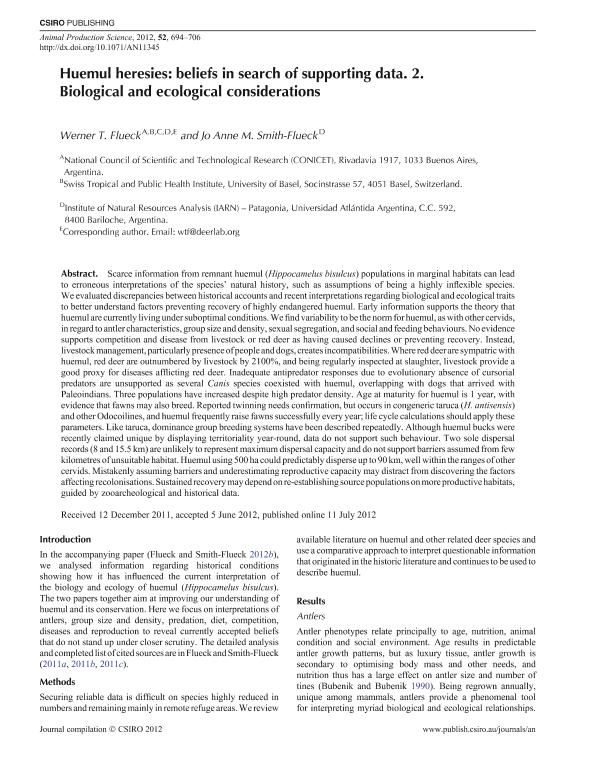Artículo
Huemul heresies: Beliefs in search of supporting data. 2. Biological and ecological considerations
Fecha de publicación:
07/2012
Editorial:
Csiro Publishing
Revista:
Animal Production Science
ISSN:
1836-5787
Idioma:
Inglés
Tipo de recurso:
Artículo publicado
Clasificación temática:
Resumen
Scarce information from remnant huemul (Hippocamelus bisulcus) populations in marginal habitats can lead to erroneous interpretations of the species' natural history, such as assumptions of being a highly inflexible species. We evaluated discrepancies between historical accounts and recent interpretations regarding biological and ecological traits to better understand factors preventing recovery of highly endangered huemul. Early information supports the theory that huemul are currently living under suboptimal conditions. We find variability to be the norm for huemul, as with other cervids, in regard to antler characteristics, group size and density, sexual segregation, and social and feeding behaviours. No evidence supports competition and disease from livestock or red deer as having caused declines or preventing recovery. Instead, livestock management, particularly presence of people and dogs, creates incompatibilities. Where red deer are sympatric with huemul, red deer are outnumbered by livestock by 2100%, and being regularly inspected at slaughter, livestock provide a good proxy for diseases afflicting red deer. Inadequate antipredator responses due to evolutionary absence of cursorial predators are unsupported as several Canis species coexisted with huemul, overlapping with dogs that arrived with Paleoindians. Three populations have increased despite high predator density. Age at maturity for huemul is 1 year, with evidence that fawns may also breed. Reported twinning needs confirmation, but occurs in congeneric taruca (H. antisensis) and other Odocoilines, and huemul frequently raise fawns successfully every year; life cycle calculations should apply these parameters. Like taruca, dominance group breeding systems have been described repeatedly. Although huemul bucks were recently claimed unique by displaying territoriality year-round, data do not support such behaviour. Two sole dispersal records (8 and 15.5 km) are unlikely to represent maximum dispersal capacity and do not support barriers assumed from few kilometres of unsuitable habitat. Huemul using 500 ha could predictably disperse up to 90 km, well within the ranges of other cervids. Mistakenly assuming barriers and underestimating reproductive capacity may distract from discovering the factors affecting recolonisations. Sustained recovery may depend on re-establishing source populations on more productive habitats, guided by zooarcheological and historical data.
Palabras clave:
HIPPOCAMELUS BISULCUS
,
HISTORY
,
ECOLOGY
,
REPRODUCTION
Archivos asociados
Licencia
Identificadores
Colecciones
Articulos(CCT - MAR DEL PLATA)
Articulos de CTRO.CIENTIFICO TECNOL.CONICET - MAR DEL PLATA
Articulos de CTRO.CIENTIFICO TECNOL.CONICET - MAR DEL PLATA
Citación
Fluck, Werner Thomas; Smith-Flueck, Jo Anne M.; Huemul heresies: Beliefs in search of supporting data. 2. Biological and ecological considerations; Csiro Publishing; Animal Production Science; 52; 8; 7-2012; 694-706
Compartir
Altmétricas




